“That in black ink, my love may still shine bright.” — Sonnet 65.
For the average Bardophile, there is no place more special than Stratford-Upon-Avon. It is the town where Shakespeare was (probably) born1 and grew up. It is where his family lived while he toiled away on the stages of London. And its where he’s buried upon threat of curse. So if you’d like to make a pilgrimage to the epicenter of the Shakespeare-verse, here’s a guide.
The town vibes
The town of Stratford-upon-Avon is a melding of historic English village along a slow-moving stream that has been fused with touches to the taste of a tourist from the kitschy to the high-end. There are posh restaurants and Elizabethan pubs. It’s a lovely place to take a stroll along the River Avon with an ice cream cone, or sun yourself in Bancroft Gardens as buskers recite Shakespeare’s iconic lines. It’s also an easy place from which to access the idyllic villages of the Cotswolds.
Getting there
I’ve traveled to Stratford by bus and by car. It’s about a two hour drive from Heathrow Airport, but the town itself has narrow streets and limited parking. If you’re adept at left-hand driving on streets built for carriages with stone walls on either side, have at it. For me, I prefer a train.
Unfortunately, there isn’t a direct train route from London to Stratford, so you’ll have to transfer along the way. Tickets can be bought here. I bought tickets ahead of time (because I am who I am), but there are also kiosks at the train station if you want to risk it (but beware of football game days, like, seriously; I’ve never seen a London train so crowded). I chose to go during off-peak hours so it cost me about $84.
There were three trains. The first is the express London underground train from the Heathrow Terminals 2 & 3 stop to Paddington (PAD) in central London. It’s clean and there are no stops along the way. Then I took the underground to the London Marylebone Station (MYB). MYB is a railroad station with some food and coffee shop options.
From there, I took the train from Marylebone to Dorridge (DDG), which was about two hours, sparsely populated, and an easy distance for some post-jet-lag napping as needed. The trains have electrical outlets (don’t forget your adapters!). The station in Dorridge has a cute little cafe (and not much else).
Finally, I took the 20-30 minute train over to Stratford (SAV). Then it’s about a ten-minute walk into town.
Where I stayed
I stayed in a quaint hotel right in the center of Stratford called The Townhouse. It’s located across the street from the schoolhouse Shakespeare attended as a child and catty-corner to the beautiful gardens built on the remnant’s of Shakespeare’s New House. It has a cute cafe and bar on the first floor. The continental breakfast is pretty bare-bones (pastries, fruit, yogurt, and coffee/tea), but there’s a tasty hot breakfast for sale.
The building has its own history, which is what drew me to it. The back-building dates to Shakespeare’s day when it was the home of the Sadler family. The front rooms were added in 1768. In the renovations over the years, they’ve kept the charm of the historic home.
From The Townhouse, it’s about a five-minute walk down to the River Avon and the Royal Shakespeare Theatre, and a ten-minute walk to the pedestrian street where you can stroll among kitschy shoppes and visit Shakespeare’s Birthplace.
Speaking of…
Things to Do
Shakespeare’s Birthplace Trust
One of the main attractions in Stratford is the home Shakespeare’s family owned at the time he was born and where he grew up. There’s an informative tour as you walk along the uneven stone floor and low ceilings touring the rooms that have been staged as they may have been when Shakespeare was a boy. I’d recently read “Hamnet” by Maggie O’Farrell that fictionalizes Shakespeare’s biography from the perspective of his son, Hamnet, and wife, Anne Hathaway, so it was especially fun to walk room to room and imagine what life was like for them.
One particularly lovely exhibit in the home is a very special window. It initially overlooked Henley Street and for centuries, people would pilgrimage to the home to etch their names in it, including famous poets and writers. You can read more about it here.
And speaking of famous writers, the home was actually saved for posterity by efforts of Charles Dickens and Sir Arthur Conan Doyle. The story goes that P.T. Barnum began showing interest in buying the home, and so Dickens, Doyle, and what became the Shakespeare Birthplace Trust hurriedly bought the place before that tacky American could get his hands on it (said with love for my fellow tacky Americans).
Along with the house itself, there’s a lovely back garden where actors perform snippets of Shakespeare among the flowers on select days. Schedule here. They do a delightful job of making the selections fun and accessible for all ages.
The tour of the property starts in an exhibition hall. When I visited, the exhibition was on James I and witches. You can find more about the exhibit here.
Tickets can be bought here or on site. Personally, I did the group ticket that gives access to the Birthplace, New House, and and Hathaway’s Cottage. I’ve still never been to Hathaway Cottage (the family home of Shakespeare’s wife, Anne Hathaway) because it’s not walkable from Stratford. I also completely forgot to visit Shakespeare’s grave at Holy Trinity Church. He’s honored in Westminster Abbey, but the warning on his Stratford grave provides “blest be the man that spares these stones and curst be he that moves my bones” and so in Stratford his body lies.
Shakespeare’s New Place
Shakespeare’s New Place
Shakespeare’s New Place, as the property is called, is the site of the home Shakespeare lived in at the time of his death. He purchased the house in 1597, four years after he made the initial offer. This delay was due to the fact that the eldest son of the homeowner murdered his father in an effort to prevent the loss of his inheritance. Shakespearean, I know.
Sadly, Shakespeare’s only son died the year before the family moved into the home in 1596. But the surviving members of the family, including Shakespeare’s father, moved into the New Place once purchased.
The house itself was the largest in Stratford. Shakespeare most likely walked by it as a child on his way to school. He upgraded it with the addition of an ostentatious number of chimneys (given the chimney tax, that was a means of flaunting one’s wealth). It was at that house that Shakespeare died.
An eventual owner tore down the house to build a more in-fashion structure. This was before Garrick’s 100-year jubilee, so Shakespeare the man was not particularly famous. That second house was then demolished by a preacher in part because he was tired of people knocking on the door and asking to tour “Shakespeare’s house.” But the primary reason was he was bitter that the town wouldn’t lower his taxes. Out of spite, he left the rubble on the lot until he died. His widow then sold it to the Shakespeare trust with the assistance of Charles Dickens and Sir Arthur Conan Doyle.
The one potential remnant of Shakespeare on the lot is an old mulberry tree. The original was sold by the preacher for its wood (there’s an irony in a religious figure attempting to bulldoze Shakespeare’s legacy). A cutting of that tree was replanted and grows on the land. The tree has been tested and it’s confirmed that it can be aged to Shakespeare’s ownership of the property.
Even though the house was demolished long ago, the property is worth visiting. They do a lovely talk about Shakespeare and the home, and they’ve marked out where the rooms would have begun and ended on the ground. There are also delightful little metal tags in the stone commemorating each sonnet, and a garden with brightly colored flags for each play (from oldest to most recent). There are inventive sculptures scattered about, including, in the back garden, lovely sculptures blending character and page to represent different Shakespeare plays.
I procrastinated on visiting the New Place because the building was long gone, but it ended up being one of my favorite locations to visit.
The Royal Shakespeare Company Theatre
Approaching from the west, the Royal Shakespeare Company (RSC) theatre rises like a fortress alongside the gentle River Avon. It is as beautiful as it is imposing. You can go up in the high tower to get a view of the town, and take a tour of the backstage workings, including the technical booths, and costume and prop shops. We even watched a little video about the 18 month process of planning, casting, preparing, and putting up a show.
They’ve recently renovated the costume shop with informational plaques and large windows to watch the craft people work their magic. There are shops for hats and boot, shops for spray painting, and shops for experimenting with plant-based dyes to cut down on chemicals.
But primarily, it’s a theater (or theatre). The RSC tends to present Shakespeare’s canon in inventive and colorful ways. I saw a filmed production of their King John where one of the major battles was turned into a food fight. I sadly visited the weekend between runs, so there was no Shakespeare playing. But if you get an opportunity to go, please do. The schedule can be found here (but note that there are several theaters, so make sure you’re looking at the correct building). There are two theaters in the RSC Theatre and another down the street at The Other Place.
The Other Place
The Other Place was built as a temporary space during the renovation of the RSC Theatre in the early 2000s. However, the RSC found use for the space for newer place and rehearsal space. There’s a cute cafe on the first floor and a magnificent costume repository on an upper floor. You can tour the costume repository or even rent certain costumes if you live in the UK. On the tour, we walked along rows of bloody Caesar togas and Cleopatra’s garb, and more chain mail than you could swing a cat at. We saw a robe worn by David Tennant and a dress worn by Dame Judi Dench.
Between the RSC Theatre and The Other Place, is a delightful little pub called The Dirty Duck where many theatergoers pop in for a bite or a pint before or after a show.
Bancroft Gardens
There is a lovely park in front of the RSC Theatre, known as Bancroft Gardens. Often, there are buskers singing or performing Shakespearean pieces. There are several sculptures, and a walking path along the river. Across the river there is a Ferris Wheel and some cafes and restaurants. You can even take boat trips on the river.
Happy Travels!
-LL
There’s a theory he was actually born a town over because of an outbreak of plague.





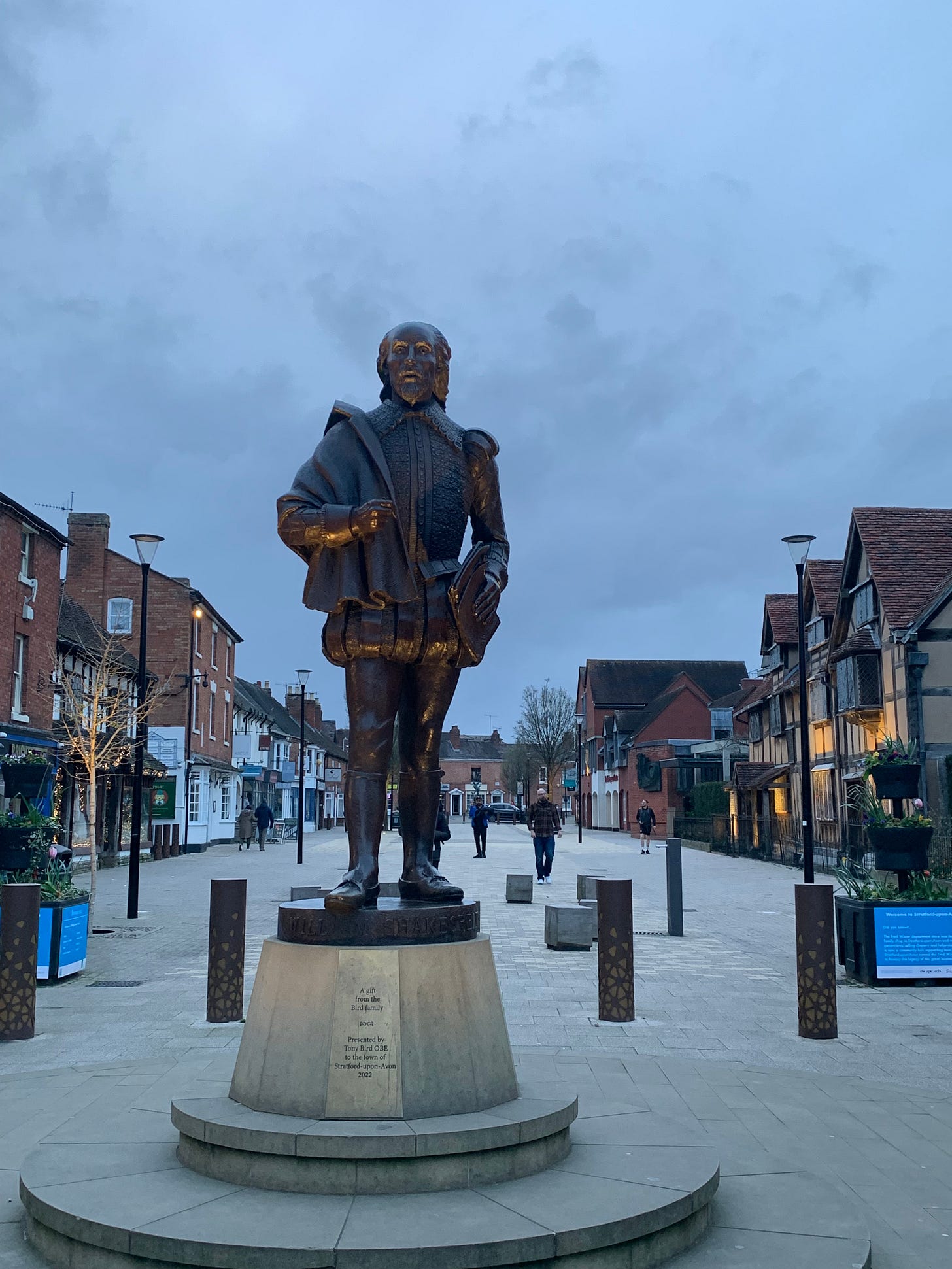

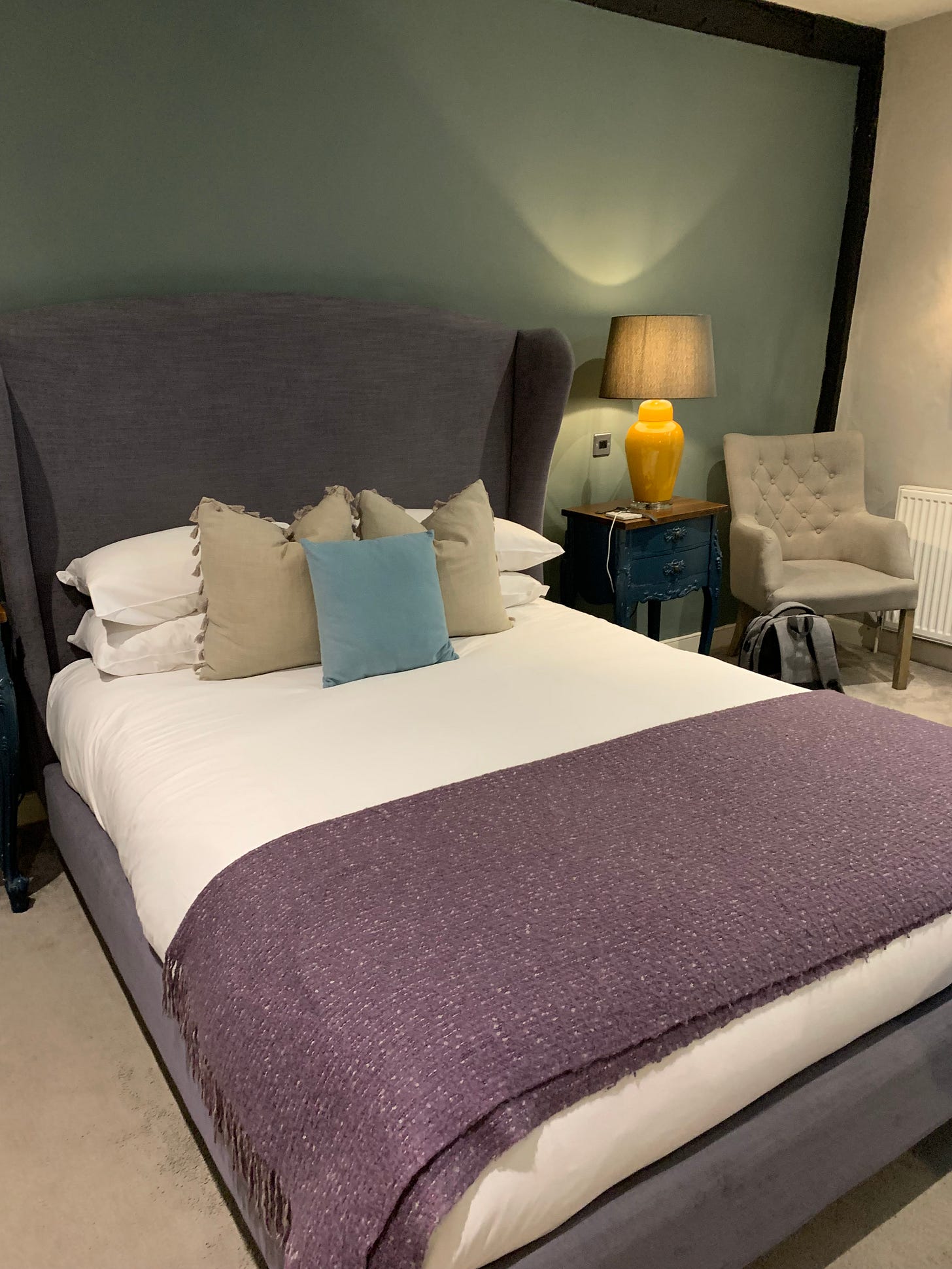
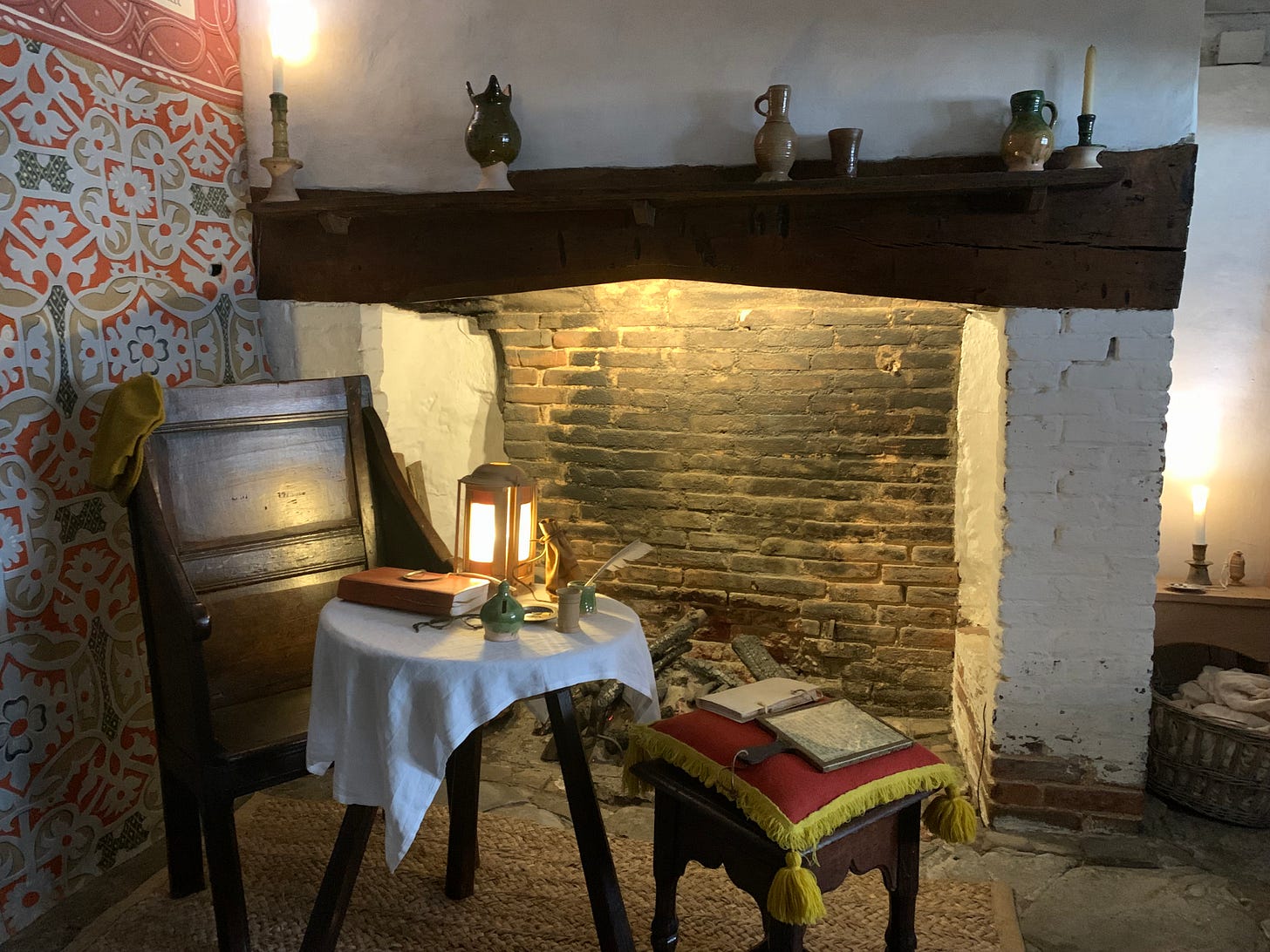
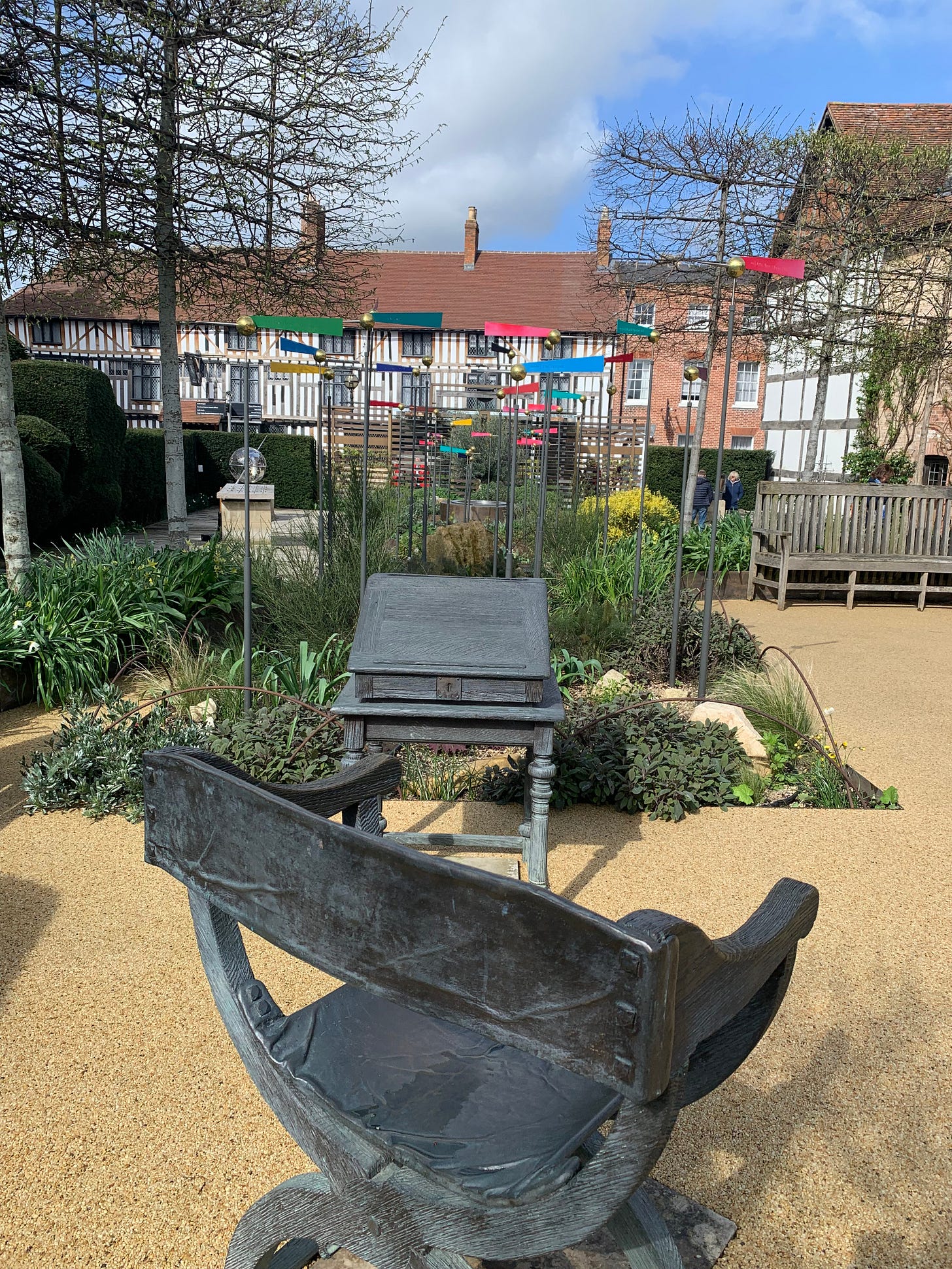
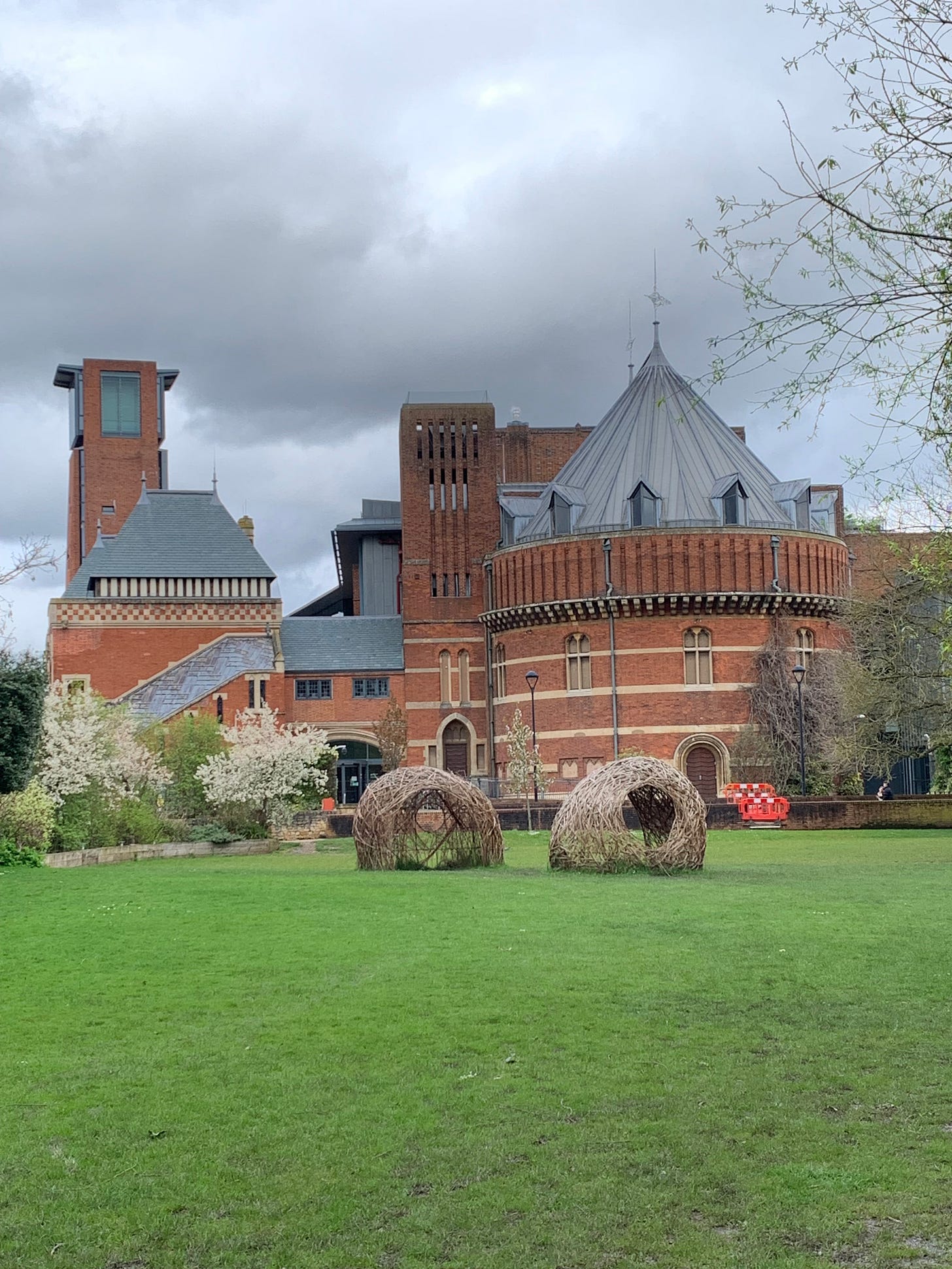

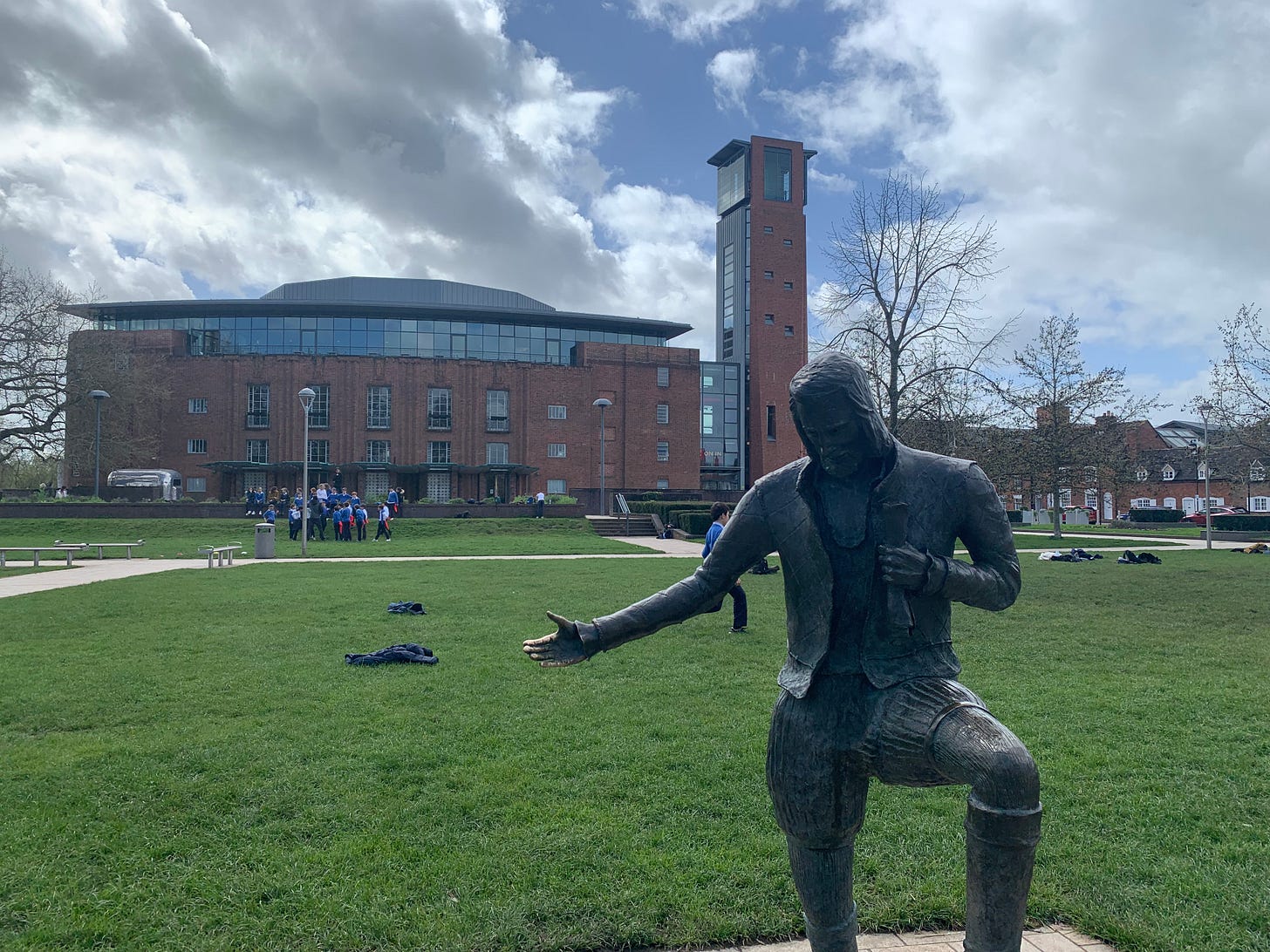
I had the pleasure of visiting Stratford for the first time last summer, and greatly enjoyed my day-and-a-half there. Well worth a visit for any fan of Shakespeare. I also did not get to see RSC playing, but I did grab a bite at the Dirty Duck.